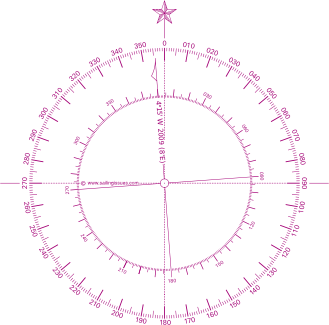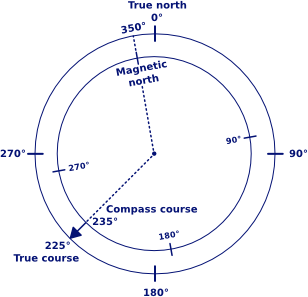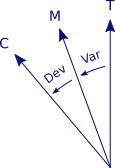Marine compass
In China compasses have been in use since the Han dynasty (2nd century BCE to 2nd century CE) when they were referred to as “south-pointers”. However at first these magnets were only used for geomancy much like in the art of Feng Shui. Eventually, during the Sung dynasty (1000 CE) many trading ships were then able to sail as far as Saudi Arabia using compasses for marine navigation. Between 1405 and 1433, Emperor Chu Ti's Treasure Fleet of the Dragon Throne ruled the entire South Pacific and the Indian Ocean, a territory that ranges from Korea and Japan to the Eastern coast of Africa.At this time Western mariners were still rather ignorant of the navigational use of the magnet. Petrus Perigrinus van Maricourt
Much later, in 1545, Pedro de Medina (Sevilla 1493-1567) wrote the Spanish standard work “Arte de Navegar” on marine compass navigation. This masterpiece was first translated in Dutch (1580) and was -O Irony- used by Jacob van Heemskerk
Magnetic Variation
In the fin-de-siècle of the sixteenth century mariners believed that the magnetic north pole coincided with the geographic north pole. Any suggestion otherwise had been denied by Pedro de Medina. Magnetic observations made by explorers in subsequent decades showed however that these suggestions were true. But it took until the early nineteenth century, to pinpoint the magnetic north pole somewhere in Arctic Canada (78° N , 104° W). From then on the angle between the true North and the Magnetic North could be precisely corrected for. This correction angle is called magnetic variation or declination.
Magnetic observations made by explorers in subsequent decades showed however that these suggestions were true. But it took until the early nineteenth century, to pinpoint the magnetic north pole somewhere in Arctic Canada (78° N , 104° W). From then on the angle between the true North and the Magnetic North could be precisely corrected for. This correction angle is called magnetic variation or declination. It is believed that the Earth's magnetic field is produced by electrical currents that originate in the hot, liquid, outer core of the rotating Earth. The flow of electric currents in this core is continually changing, so the magnetic field produced by those currents also changes. This means that at the surface of the Earth, both the strength and direction of the magnetic field will vary over the years. This gradual change is called the secular variation of the magnetic field. Therefore, variation changes not only with the location of a vessel on the earth but also varies in time.
The correction for magnetic variation for your location is shown on the nearest! nautical chart's compass rose. In this example we find a variation of 4° 15' W in 2009, with an indicated annual correction of 0° 08' E. Hence, in 2011 this variation is estimated to be 3° 59', almost 4° West. This means that if we sail 90° on the chart (the true course), the compass would read 94°.
Another example: let's say the compass rose gives a variation of 2° 50' E in 2007, with a correction of 0° 04' E per year. In 2009 this variation is estimated to be 2° 58', almost 3° East. Now, if we sail 90° on the chart, the compass would read 87°.
Correcting for variation
 These overlayed compass roses show the difference between true north and magnetic north when the magnetic variation is 10° West. From the image we find: tc = cc + var
These overlayed compass roses show the difference between true north and magnetic north when the magnetic variation is 10° West. From the image we find: tc = cc + var in which “cc” and “tc” stand for “compass course” and “true course”, respectively.
To convert a true course into a compass course we need first assign a “-” to a Western and a “+” to a Eastern variation. Note that this makes sense! because of the clockwise direction of the compass rose. Here, the inner circle is turned 10° anticlockwise, hence -10°
Now, use the same but re-written equation:
cc = tc - var
235° = 225° - (-10°)
So, to sail a true course of 225°, the helmsman has to steer a compass course of 235°.
To convert a compass course into a true course we can use the original equation. If we have steered a compass course of 200°, we have to plot a true course of 203° in the chart if the variation is 3° East
Magnetic deviation
Magnetic deviation is the second correctable error. The deviation error is caused by magnetic forces within your particular boat. Pieces of metal, such as an engine or an anchor, can cause magnetic forces. And also stereo and other electric equipment or wiring, if too close to the compass, introduce errors in compass heading. Furthermore, the deviation changes with the ship's heading, resulting in a deviation table as shown below. The vertical axis states the correction in degrees West or East, where East is again positive.
The horizontal axis states the ship's heading in degrees divided by ten. Thus, when you sail a compass course of 220°, the deviation is 4° W. (Note, that on most modern sailing yachts the deviation is usually not larger than 3°). When a compass is newly installed it often shows larger deviations than this and needs compensation by carefully placing small magnets around the compass. It is the remaining error that is shown in your deviation table.
You can check your table every now and then by placing your boat in the line of a pair of leading lights and turning her 360 degrees.
Correcting for both deviation and variation
Converting a compass course into a true course, we can still use our equation but we need to add the correction for deviation:cc + var + dev = tc
- Example 1: The compass course is 330°, the deviation is +3° (table) and the variation is +3° (chart);
330° cc + 3° var + 3° dev = ?° tc
giving a true course of 336° which we can plot in our chart
- Example 2: The compass course is 220°, the deviation is -4° (table) and the variation is still +3° (chart).
220° cc + 3° var + -4° dev = ?° tc
giving a true course of 219°. - Example 3: The compass course is still 220°, therefore the deviation is still -4° (table) but let's use a variation of -10° this time.
220° cc + -10° var + -4° dev = ?° tc
giving a true course of 206°.
- Example 4: The true course from the chart is 305° and the variation is +3° (chart), yet we don't know the deviation;
?° cc + 3° var + ?° dev = 305° tc
Luckily, we can rewrite this so this reads:
cc + dev = 305° tc - + 3° var = 302°
In plain English: the difference between the true course and the variation (305 - + 3) = 302 should also be the summation of the compass course and the deviation. So, we can tell our helms person to steer 300°, since with a cc of 300° we have a deviation of +2° (As can be deduced from the deviation table above). - Example 5: The true course from the chart is 150° and we have a Western variation of 7 degrees (-7°). We will use the rewritten equation to get:
150° tc - - 7° var = cc + dev = 157°
From the deviation table we find a compass course of 160° with a deviation of -3°.
Voilà!
Magnetic course
The magnetic course (mc) is the heading after magnetic variation has been considered, but without compensation for magnetic deviation. This means that we are dealing with the rewritten equation from above:tc - var = cc + dev = mc. Magnetic courses are used for three reasons:

- To convert a true course into a compass course like we saw in the last paragraph.
- On vessels with more than one steering compass, also more deviation tables are in use; hence only a magnetic or true course is plotted in the chart.
- Bearings taken with a handheld compass often don't require a correction for deviation, and are therefore useful to plot in the chart as magnetic courses.
Note, that the actual course lines the navigator draws in the chart are always true courses! These can subsequently be labeled with the true course or the corresponding magnetic or compass course if appropriate.

No comments:
Post a Comment